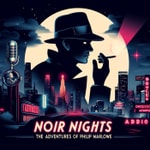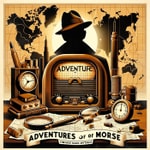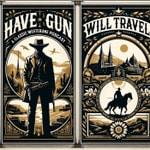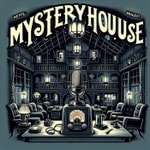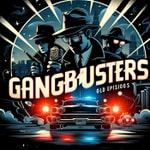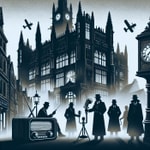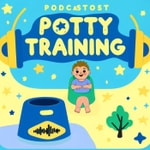Music History Daily – Details, episodes & analysis
Podcast details
Technical and general information from the podcast's RSS feed.
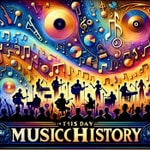
Music History Daily
Quiet. Please
Frequency: 1 episode/1d. Total Eps: 444

Whether you crave a blast of music nostalgia, enjoy a good music trivia challenge, or want to expand your music discovery horizons, "Music History Daily" has something for you. Uncover the stories that bring the music alive, from chart-toppers to hidden gems. Get ready to rediscover the power of music and why it holds a special place in our hearts.
For more info check out https://www.quietperiodplease.com/
Recent rankings
Latest chart positions across Apple Podcasts and Spotify rankings.
Apple Podcasts
🇺🇸 USA - musicHistory
23/07/2025#100🇬🇧 Great Britain - musicHistory
27/03/2025#95🇬🇧 Great Britain - musicHistory
26/03/2025#90🇬🇧 Great Britain - musicHistory
25/03/2025#76🇬🇧 Great Britain - musicHistory
24/03/2025#66🇬🇧 Great Britain - musicHistory
23/03/2025#60🇺🇸 USA - musicHistory
12/03/2025#73🇨🇦 Canada - musicHistory
08/03/2025#85🇨🇦 Canada - musicHistory
07/03/2025#64🇨🇦 Canada - musicHistory
06/03/2025#59
Spotify
No recent rankings available
Shared links between episodes and podcasts
Links found in episode descriptions and other podcasts that share them.
See all- http://www.quietplease.ai
2598 shares
- https://www.quietperiodplease.com/
551 shares
- https://amzn.to/49SJ3Qs
185 shares
RSS feed quality and score
Technical evaluation of the podcast's RSS feed quality and structure.
See allScore global : 64%
Publication history
Monthly episode publishing history over the past years.
This Moment in Music History for 09-10-2024
mardi 10 septembre 2024 • Duration 02:26
The album's creation was a challenging process for the band, as they struggled with the absence of Barrett and the pressure to follow up their hugely successful previous album, "The Dark Side of the Moon." Despite these difficulties, Pink Floyd managed to create a masterpiece that showcased their incredible musicianship and storytelling abilities.
The album opens with the haunting sound of a radio tuning in, followed by the gentle guitar intro of "Shine On You Crazy Diamond," a nine-part composition that bookends the album. This song is a heartfelt tribute to Barrett, with lyrics that describe his rise and fall in the music industry.
Other standout tracks on the album include the title track, "Wish You Were Here," which features a memorable acoustic guitar riff and lyrics that express the band's longing for Barrett's presence. The song "Welcome to the Machine" is a scathing critique of the music industry, while "Have a Cigar" features guest vocals by Roy Harper and satirizes the business side of rock stardom.
"Wish You Were Here" was an instant commercial and critical success, reaching the top of the charts in several countries and cementing Pink Floyd's status as one of the most innovative and influential bands of their era. The album's themes of absence, loss, and the corrupting influence of fame and success continue to resonate with listeners to this day.
In a fitting tribute to the album's legacy, the cover art features a photograph of a man shaking hands with another man who is on fire, symbolizing the band's feelings of being "burned" by the music industry. This iconic image has become one of the most recognizable album covers in rock history.
Overall, the release of "Wish You Were Here" on September 10th, 1975, marked a significant moment in music history, showcasing the incredible talent and creativity of one of the world's most beloved rock bands.
This Moment in Music History for 09-09-2024
lundi 9 septembre 2024 • Duration 01:56
Elvis had already gained popularity with hits like "Heartbreak Hotel" and "Hound Dog," but his appearance on the "Ed Sullivan Show" exposed him to an even wider audience. The show was watched by an estimated 60 million viewers, which was a record for television at the time.
During his performance, Elvis sang "Don't Be Cruel," "Love Me Tender," "Ready Teddy," and "Hound Dog." His energetic stage presence, coupled with his distinctive voice and provocative hip movements, caused a sensation among the audience. Some viewers were scandalized by his performance, while others were enthralled.
The "Ed Sullivan Show" had initially been reluctant to book Elvis, considering him too controversial. However, after his popularity continued to grow, the show's producers eventually relented. Elvis's appearance on the show helped to break down barriers in the music industry and paved the way for other rock and roll artists to gain mainstream acceptance.
Elvis's performance on the "Ed Sullivan Show" on September 9th, 1956, is considered a landmark moment in music history. It showcased the power of television to create cultural phenomena and helped establish rock and roll as a dominant force in popular music. Elvis's legacy as the "King of Rock and Roll" continues to this day, and his influence can still be felt in music and popular culture.
This Moment in Music History for 08-29-2024
jeudi 29 août 2024 • Duration 01:49
The Fab Four had been touring relentlessly for over three years, and the strain of constant performances, travel, and screaming fans had taken its toll. The decision to stop touring was made earlier that year, and the Candlestick Park show would be their final live performance as a band.
The setlist for the concert included classic hits like "Rock and Roll Music," "She's a Woman," "If I Needed Someone," "Day Tripper," "Baby's in Black," "I Feel Fine," "Yesterday," and "I Wanna Be Your Man." Despite the historical significance of the event, the concert itself was far from perfect. The sound system was poor, and the band struggled to hear themselves over the screaming audience of around 25,000 fans.
Interestingly, the Beatles were not even the headlining act that night. They were opening for the Remains, Bobby Hebb, the Cyrkle, and the Ronettes. The show lasted just 33 minutes, and the band was paid $90,000 for their performance, which would be equivalent to around $750,000 today.
After the concert, the Beatles returned to the studio, focusing on creating more experimental and innovative music that would define the latter part of their career. The Candlestick Park performance marked the end of an era for the band and their fans, and it remains a significant moment in music history.
This Moment in Music History for 05-31-2024
vendredi 31 mai 2024 • Duration 02:14
The Who, one of the most influential rock bands of all time, were at the height of their popularity in 1976. The concert at The Valley was part of their UK tour supporting their latest album, "The Who by Numbers." The band consisted of Roger Daltrey (vocals), Pete Townshend (guitar), John Entwistle (bass), and Keith Moon (drums).
The show was particularly memorable for a few reasons. Firstly, it was the largest concert The Who had ever played in the UK, with an estimated audience of 80,000 people. The stage setup was massive, featuring a huge lighting rig and a giant inflatable pig, which was a nod to their rock opera "Tommy."
Secondly, the setlist was incredible, featuring some of The Who's most iconic songs, such as "My Generation," "Pinball Wizard," "Behind Blue Eyes," and "Won't Get Fooled Again." The band played with their usual raw energy and power, with Townshend's windmill guitar strums, Daltrey's powerful vocals, Entwistle's thunderous bass, and Moon's manic drumming.
However, the most notable moment of the show came during the encore. As the band returned to the stage, Keith Moon, known for his wild antics, began kicking over his drum kit. Soon, the rest of the band joined in, smashing their instruments and destroying the stage. The crowd went wild, and the moment has since become one of the most iconic in rock history.
The concert was recorded and later released as a live album titled "The Who Put the Boot In," which captured the raw energy and power of the band at their peak. It remains a classic live album and a testament to the incredible legacy of The Who.
This Moment in Music History for 05-30-2024
jeudi 30 mai 2024 • Duration 02:11
The Beatles had recently returned from their trip to India, where they spent time studying Transcendental Meditation with Maharishi Mahesh Yogi. This experience had a profound impact on their music and inspired many of the songs that would appear on the "White Album."
The recording sessions for the album were notably different from the band's previous work. Instead of focusing on tight collaboration and unified sound, each member of The Beatles began to work more independently, often recording their parts separately. This approach resulted in a diverse and eclectic collection of songs, showcasing the individual talents and interests of John Lennon, Paul McCartney, George Harrison, and Ringo Starr.
Some of the most iconic songs from the "White Album" include "Back in the U.S.S.R.," "While My Guitar Gently Weeps," "Blackbird," "Helter Skelter," and "Revolution 1." The album also featured some experimental tracks, such as "Revolution 9," which was an avant-garde sound collage.
The "White Album" sessions were not without tension, as the band members' creative differences and personal issues began to surface. However, despite the challenges, they managed to create a groundbreaking double album that pushed the boundaries of what was possible in rock music.
Released on November 22, 1968, the "White Album" received mixed reviews initially but has since been recognized as one of The Beatles' most innovative and influential works. It stands as a testament to the band's unparalleled creativity and their ability to constantly reinvent themselves, even as they approached the end of their remarkable career together.
This Moment in Music History for 05-29-2024
mercredi 29 mai 2024 • Duration 01:44
The ballet, choreographed by Vaslav Nijinsky and performed by Sergei Diaghilev's Ballets Russes, depicts a pagan ritual in which a young girl dances herself to death as a sacrifice to the god of spring. The music's primal, pulsating rhythms and the dancers' unconventional, stomping movements were unlike anything the Parisian audience had seen or heard before.
The crowd's reaction was tumultuous, with some audience members jeering, hissing, and even throwing objects at the stage. The noise became so loud that the dancers had difficulty hearing the music, and Nijinsky had to shout out the counts from backstage to keep the performance going.
Despite the initial outrage, "The Rite of Spring" became a seminal work in 20th-century music, influencing countless composers and revolutionizing the way people thought about music and dance. Today, it is widely regarded as one of the most important and influential pieces of music ever composed, and its premiere remains a pivotal moment in the history of modernism and the avant-garde.
This Moment in Music History for 05-28-2024
mardi 28 mai 2024 • Duration 02:04
The Rolling Stones, already a legendary rock band by this time, decided to perform a surprise gig at the small Toronto club under the pseudonym "The Cockroaches." The 300-capacity venue was packed with unsuspecting fans who were treated to an intimate and electrifying performance by Mick Jagger, Keith Richards, Charlie Watts, Bill Wyman, and Ronnie Wood.
The setlist included classic hits like "Jumpin' Jack Flash," "Honky Tonk Women," and "Brown Sugar," as well as blues covers and deep cuts. The raw energy and excitement of the crowd can be heard throughout the recordings, with Jagger's dynamic vocals and the band's tight instrumentation shining through.
Four songs from this legendary show – "Mannish Boy," "Crackin' Up," "Little Red Rooster," and "Around and Around" – were included on the "Love You Live" album, released in September 1977. The album, featuring recordings from various tours between 1975 and 1977, showcased The Rolling Stones' live prowess and their ability to captivate audiences with their music.
The El Mocambo recordings have since become a sought-after bootleg among fans and collectors, serving as a testament to the band's enduring legacy and their ability to deliver unforgettable performances in any setting. The surprise gig at the small Toronto club remains a highlight in The Rolling Stones' storied career and a significant moment in music history.
This Moment in Music History for 05-27-2024
lundi 27 mai 2024 • Duration 01:54
Despite the ban, or perhaps because of it, "God Save the Queen" rocketed up the charts, peaking at number two on the UK Singles Chart (though many believed it actually outsold the official number one, Rod Stewart's "I Don't Want to Talk About It"). The song's success was a testament to the growing influence of punk rock and its ability to challenge societal norms and institutions.
The release of "God Save the Queen" solidified the Sex Pistols' reputation as one of the most controversial and influential bands of their era. Their raw, aggressive sound and confrontational lyrics paved the way for countless punk and alternative acts in the decades that followed.
Interestingly, the song's release date was no coincidence. The band's manager, Malcolm McLaren, deliberately chose to release the single just before the Queen's Jubilee celebrations, maximizing its impact and controversy. This clever marketing strategy helped cement the Sex Pistols' place in music history and ensured that "God Save the Queen" would remain a rebellious anthem for generations to come.
This Moment in Music History for 05-26-2024
dimanche 26 mai 2024 • Duration 02:47
"Sgt. Pepper's Lonely Hearts Club Band" was the eighth studio album by The Beatles and was recorded over a period of 129 days, from December 6, 1966, to April 21, 1967. The album was a departure from the band's previous works, as it featured a more experimental and psychedelic sound, incorporating elements of rock, pop, classical, and avant-garde music.
The album's concept was based on the idea of a fictional Edwardian military band, with the Beatles assuming alter egos as members of the band. The album cover, designed by pop artist Peter Blake and his wife Jann Haworth, featured a colorful collage of life-sized cardboard cut-outs depicting the band members in their Sgt. Pepper uniforms, surrounded by a diverse array of famous figures from history and popular culture.
The album's tracklist included some of The Beatles' most iconic songs, such as "With a Little Help from My Friends," "Lucy in the Sky with Diamonds," "When I'm Sixty-Four," and the title track "Sgt. Pepper's Lonely Hearts Club Band." The album also featured the use of innovative recording techniques, such as tape loops, sound effects, and orchestral arrangements, which added depth and complexity to the songs.
Upon its release, "Sgt. Pepper's Lonely Hearts Club Band" received widespread critical acclaim and commercial success. It spent 27 weeks at the top of the UK Albums Chart and 15 weeks at number one on the US Billboard 200. The album won four Grammy Awards in 1968, including Album of the Year, the first rock album to receive this honor.
The impact of "Sgt. Pepper's Lonely Hearts Club Band" on the music industry and popular culture cannot be overstated. It marked a turning point in the evolution of rock music, paving the way for concept albums, studio experimentation, and the integration of various musical genres. The album's influence can still be felt today, more than five decades after its release, cementing its status as one of the greatest and most influential albums of all time.
This Moment in Music History for 05-25-2024
samedi 25 mai 2024 • Duration 02:15
The story goes that Keith Richards woke up in the middle of the night with the famous guitar riff in his head. He quickly recorded it on a portable tape recorder before falling back asleep. The next morning, he played the riff for Mick Jagger, who immediately began writing lyrics to accompany the catchy tune.
"(I Can't Get No) Satisfaction" featured a distinctive fuzz guitar sound, which was achieved by accident when Richards' guitar amplifier malfunctioned during the recording session. This happy accident contributed to the song's raw, edgy vibe that perfectly captured the rebellious spirit of the era.
The song's lyrics, which touched on themes of sexual frustration and commercialism, were considered provocative at the time. The BBC initially banned the track due to its suggestive content, but this only fueled its popularity among young listeners who were eager to challenge the status quo.
"(I Can't Get No) Satisfaction" spent four weeks at the top of the Billboard Hot 100 chart in the United States and became the Rolling Stones' first number-one hit in the country. The song's success helped establish the band as one of the most prominent acts in the British Invasion and solidified their status as rock legends.
The impact of "(I Can't Get No) Satisfaction" extends far beyond its initial release. The song has been covered by numerous artists across various genres and continues to be a staple of classic rock radio. In 2004, Rolling Stone magazine ranked it at number two on their list of "The 500 Greatest Songs of All Time," a testament to its enduring influence and popularity.
